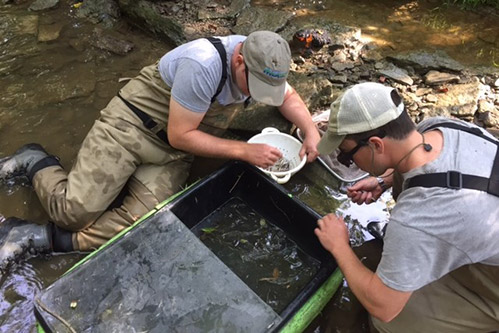Fish are widely used by federal, state, and local governments as a key biological assemblage to monitor river and stream health. This includes Ohio EPA, which uses fish as one of the two primary aquatic assemblages to evaluate aquatic life status and health. MBI offers instructional training in the concepts, methods, and applications of using fish assemblage data in environmental monitoring and assessment. The training is aimed at qualified practitioners who already have the skills needed to carry out the execution of the methods for collecting and interpreting fish assemblage data.
The focus of this training is on the methods and biocriteria used by Ohio EPA and as such fulfills the training required for those who are pursuing Level 3 Qualified Data Collector (QDC) status for Fish Community Biology Specialty under the Ohio Credible Data Program. It also includes instruction on using the QHEI, thus fulfilling the Habitat QDC requirements for Level 3. Please note that Ohio EPA recently eliminated Level 3 as a stand-alone specialty for QHEI, so obtaining Level 3 QHEI is now possible only via one of the biological assemblage specialties.
MBI and Ohio EPA work together to provide all that is necessary to obtain QDC status under the Ohio Credible Data Program. MBI provides the facilities, equipment and materials, and conducts the training over four consecutive days. Ohio EPA conducts the Level 3 testing on the fifth day and provides the certification once all lab and field testing has been completed and submitted by an applicant. New in 2019 are revised requirements for conducting the sampling and data analysis as part of the testing required by Ohio EPA. These and other requirements will be covered in Day Four of the training (see Additional Note below).
Please Note: Participants will be afforded time in the late afternoon and evenings at MBI to examine fish specimens in preparation for testing by Ohio EPA on Day Five.
Additional Note: Participants completing the Level 3 Fish Community Biology and Habitat training will need to meet new Ohio EPA requirements for collecting fish and habitat samples on their own during the field season. Ohio EPA now requires data from three (3) headwater sites, four (4) wadeable sites, and three (3) boatable sites and at locations specified by Ohio EPA. An applicant will also need to provide fish and habitat data on Ohio EPA field forms, calculate the IBI (Index of Biological Integrity) and MIwb (Modified Index of Well-Being for fish assemblages) scores, and provide either preserved or photo vouchers of each species collected at each site. Applicants should contact the Ohio EPA Credible Data Program for more information.
Day One: Introduction to Ohio WQS and Biocriteria, and QHEI
We will provide a detailed overview of the Fundamentals of Aquatic Ecology, Monitoring and Assessment Design, the Ohio Water Quality Standards (WQS), the development of numeric biocriteria and their usage. Participants will learn about the origins and components of the QHEI as a habitat assessment tool in the afternoon classroom session. An overview of the Ohio Credible Data Program and instructions about how to obtain Level 3 QDC status are also included.
Day Two: Qualitative Habitat Evaluation Index (QHEI) - Field Training
This is the field training day for QHEI, which includes a Level 2 QHEI test at the last site.
Day Three: Level 3 Field Instruction
We will provide in-field instruction for fish sampling at a wadeable and a boatable site. Participants will be instructed in Ohio EPA methods for electrofishing, including gear operation and safety. There is an option for QDC applicants to become certified in the wadeable methods only.
Day Four: Data Analysis & Use Designation Determination
Day 4 includes classroom instruction for managing and analyzing fish data including calculating the indices that comprise the Ohio biocriteria. Case studies will cover the analysis of data, including determining the appropriate use designation (i.e. Use Attainability Analysis or UAA), assessing use attainment status, and an introduction to stressor identification. We will provide instruction in the identification of external anomalies and calculation of the DELT (Deformities, Eroded Fins, Lesions & Ulcers, and Tumors) metric of the IBI. An overview of fish sampling methods includes the selection of the appropriate sampling gear in accordance with Ohio EPA methods. We will also provide instruction on how to develop a Project Study Plan (PSP) for submittal to Ohio EPA as a prerequisite to qualifying survey data as Level 3.
This completes the training conducted at and by MBI.
Post-Training Testing and Grading by Ohio EPA
Ohio EPA has assumed all responsibility for Level 3 testing and grading. MBI will provide contact information to all trainees who will then need to arrange for the testing on their own.
Recommended Background
Participants should be proficient in the identification of Ohio fish to species level and be familiar with fish sampling techniques, including electrofishing. The Ohio EPA methods manual can be found by clicking here, and will also be provided as part of the training materials.
Results
This course satisfies Ohio EPA training requirements and provdes participants with the knowledge needed to complete the required post-training testing for the Level 3 Fish Community Biology specialty, which consists of sampling the required number and types of sites for fish and QHEI (contact Ohio EPA for more information about site requirements). Ohio EPA will inform participants about their test results directly. If a passing score is received, a participant can then apply to Ohio EPA for Level 3 QDC Status. For the latest Ohio Credible Data Program requirements, visit the Ohio EPA website by clicking here.

